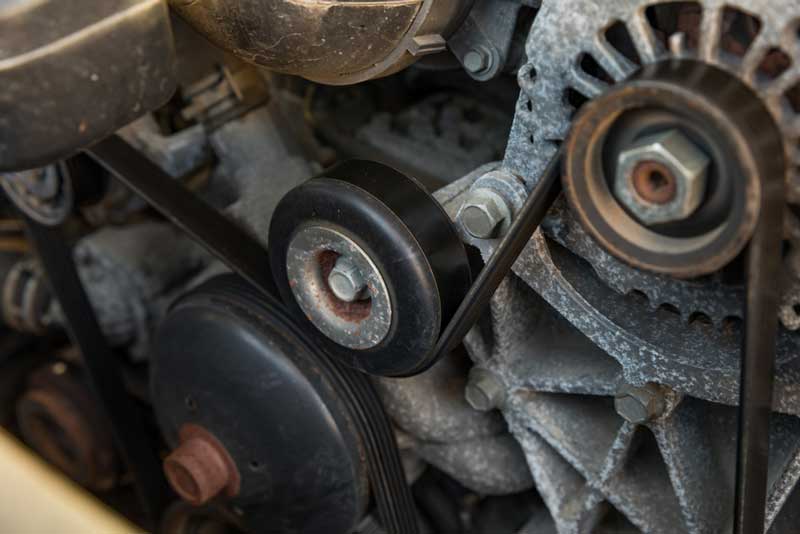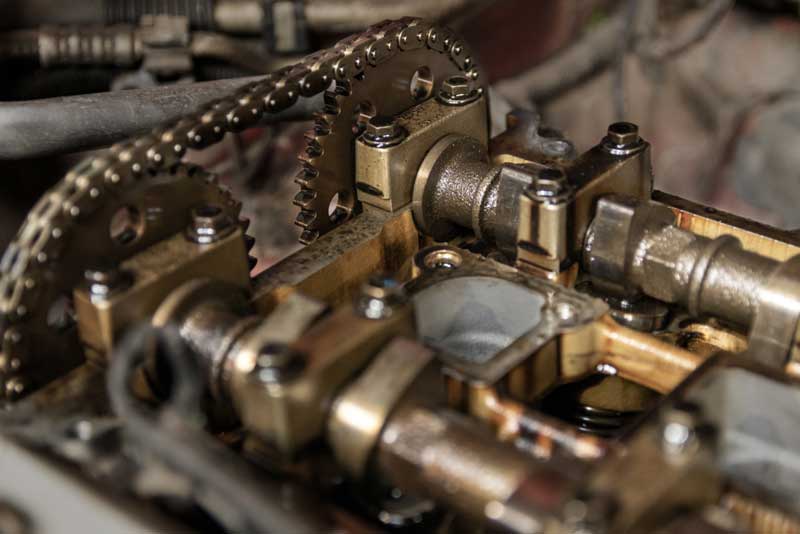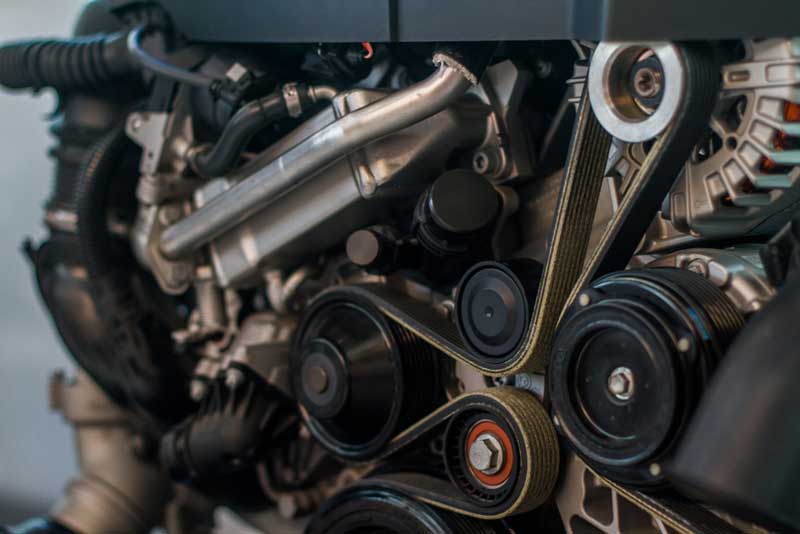Do you get confused when you open your bonnet? Do you want to understand the difference between a serpentine belt and a timing belt?
We’ve got you covered on this, so look no further.
This article discusses the difference between the timing belt and serpentine belt, including their functions in the smooth running of your vehicle.
On that note, we kick off!
Serpentine Belt vs Timing Belt
If you want to know more about the working principles of the internal combustion engine, you will have to learn the difference between the two belts.
The function of a timing belt and a serpentine belt differs greatly, but they both play an essential role in running the engine. A timing belt is found inside the engine and synchronizes the crankshaft and camshaft. this guarantees the opening and closing of the engine intake and exhaust valves in time with the pistons so the engine runs smoothly. The serpentine belt is what keeps the engine parts running smoothly and efficiently.
Meaning of a Serpentine Belt
Functions of a serpentine belt include powering the supercharge, power steering pump, air conditioner, alternator, and most times, water pump.
Initially, the serpentine belt was called a drive belt with a simpler design, because its role was only to do a power transfer to the radiator fan, water pump, and alternator from the crankshaft. A vehicle can have 1 or 2 drive belts, depending on its design.
The recent serpentine belt’s design helps maximize coverage and the engine’s footprint.
One belt needs only one crankshaft pulley, and this creates a reduction in the engine’s overall length. In addition, the belt can power a radiator fan, but due to technological advancements, electric motors are used instead, thus causing a separation between the radiator and the engine.
The crankshaft pulley provides the serpentine belt’s power to transfer. It can be found at the engine’s bottom, close to the oil sump. The auxiliary system is mostly positioned in a way that uses only a small space; the accommodation has to be done by the serpentine belt.
This can be achieved using idle pulleys that alter the approach angles, to provide better contact between the auxiliary system and the belt.
The 2 sides of a serpentine belt are different. The internal side contains a groove that gets along the belt’s length and creates better traction whenever it connects with the auxiliary system’s grooved pulleys such as power steering, AC, and alternator.
In most cars, the belt’s smooth side powers the water pump, as well as most of the idle pulleys.
There are no directional grooves on the belt, but getting the pulley and belt side matched is vital for it to function properly.
The belt has to remain under steady tension, but there will be a stretch of rubber over time. And this is where you introduce the belt tensioner, a spring-loaded pulley that fastens the belt automatically, when necessary.

Defining a Timing Belt
A timing belt has just one purpose- to time (synchronize) the crankshaft and camshaft rotation. The system comprises a timing belt, belt tensions, camshaft pulley, and crankshaft pulley. In most configurations, the belt also runs the water pump.
A timing chain is a substitute for a timing belt, but they perform the same function. The difference between the 2 will be discussed in a different section. To fully understand what is happening, we will have to discuss the basics of an internal-combustion engine operation.
You can find the crankshaft at the engine’s bottom, linked to the piston through a connecting rod.
The cranking mechanism converts a piston’s linear force, to a rotational force. The vehicle is powered by the transfer of rotational power to the timing belt, transmission, and serpentine belt.
The piston compresses the fuel-air mixture and blasts it through either a pure compression for diesel or the spark plug for petrol. To guarantee this occurs, the exhaust and intake valves have to get opened at the appropriate moment.
At this point, the timing belt will be needed. It can be found on the backside or front of the engine block, the crankshaft is connected to the camshaft by the timing belt, and their movement is synchronized. The camshaft resembles a rod with egg-shaped cams all over it.
Each cam closes and opens each valve gradually. An engine can have 1 or 2 camshafts, commonly known as DOHC- dual overhead camshaft and OHC- overhead camshaft.
You may wonder the reason behind the phrase “crank the engine “. Back in the old automotive days, you would have to insert a starting handle from the front and then crank the engine, to make it run.
With the starter’s invention, the process is automated by an electrical current instead, but the theory doesn’t change. The pistons, camshaft, and crankshaft’s first cycle must be manually done until the detonations generate enough force to take over by the pistons.
Differences Between a Timing Belt and a Serpentine Belt
The timing belt and the serpentine belt have several differences. The 3 major variations between a serpentine belt and a timing belt are listed below.
Connection to the Engine Is Not the Same
A Serpentine Belt
A serpentine belt can be found outside the vehicle engine. They are linked to a power accessory that is not a basic part of your engine. And these accessories comprise the water pump, power steering pump, air conditioner, and alternator.
You can still drive your vehicle if this belt latches, but only for a short distance. Though, suppose the power accessories fail to do their duties. In that case, it might lead to engine overheating, the interior part of the vehicle can get very hot, and driving for a longer distance may not be possible.
Luckily, the serpentine belt can be replaced easily and is affordable.
Timing Belt
Alternatively, there is a direct connection of the timing belt to your engine, via a crankshaft rod. Its major function is to rotate the camshaft and the crankshaft, to enable the opening and closing of engine valves in the engine. Unfortunately, this belt is enveloped in a steel case, and replacing it can be very difficult.
Most engines are manufactured so that the camshaft and crankshaft can stop rotating when the belt snaps. However, the pistons in the cylinder may hit any valve that is opened and cause damage to the engine, if the camshaft and the crankshaft continue turning.
Although these belts are not expensive and scarce, the replacement task could be very challenging. The cost of repairs could be hundreds of dollars, just to take off the damaged belt and fix a new belt. Then, what if your engine got destroyed?
Also Read: Temporary Fix for Crankshaft Position Sensor (Expert Guide)
Serpentine Belt Is Friction Drive While the Timing Belt Is Direct Drive
Serpentine vs. Timing belt- which one of these has a direct and friction orientation?
Serpentine Belt
A serpentine belt can be said to be friction-oriented or friction drive. The force it generates is determined by the friction between the pulleys’ surface, and the belt. Its major function is to rotate or drive all the pulleys linked to it.
Timing Belt
Alternatively, a timing belt is associated with the direct drive. This means that the belt is connected directly to the crankshaft pulley, which rotates the camshaft. The belt is cogged, and this means its inner parts have teeth.
There should be a similarity between the belt cogs, and the pulley it is linked to. With this design, the pulley will find it difficult to go under the belt. Thus, the correct synchronization is maintained between the camshaft and the crankshaft.
Cogs or Grooves Are Not the Same
How can they be compared when it comes to grooves?
The serpentine belts have a V-shaped groove. They run inside the belt’s diameter vertically.
They possess horizontal grooves, built to fit the crankshaft’s teeth or cog for timing belts.
Signs of a Failing Serpentine Belt
This belt won’t last forever, irrespective of how strong it is. Some of the signs you have to look out for include;
- Presence of cracking, glazing, fraying, or symptoms of wearing.
- Illumination of the Check Engine Light.
- Abnormal sounds from the pulleys or belts.
- Low performance, for example, power steering failure, sudden battery drain, stalled engine, etc.
- Belt chirps or squeaks (a slipping belt could cause this).

Signs of a Failing Timing Belt
These symptoms indicate a failing timing belt:
1. Slipping
A worn timing belt can cause a slip. If this happens, the fuel in the engine’s combustion chambers will be misfired incorrectly. Unfortunately, a failing timing belt has no clear symptoms. A timing belt failure seems to happen suddenly. Unlike a serpentine belt, the failure is not gradual.
2. Engine Power Failure
Immediately after a timing belt failure, the engine’s power will be lost, and it stops suddenly. If your vehicle has a timing chain, you will have a breaking or crack in the engine bay. When other engine components collide, the sound it makes can be frightening.
To avoid all these and more, adhere to the manufacturer’s recommended preventive maintenance plan, for your vehicle’s timing belt. Frequent examination of the belt will help in evaluating its state. Then, you can easily know when a replacement is needed.
Cost of Replacing a Serpentine Belt
The cost of the serpentine belts falls between $15 and $70, but changing the belt tensioner and the idle pulleys at an exact time, is a good exercise. You need about $25 for each of them. The complete kit can also be found lesser than $100.
Labor cost falls between $70 to $150, and everything in total will be around $200, but you could do this task at home if you have the right tools and the correct skill.
Cost of Replacing a Timing Belt
A timing belt is quite affordable, it costs about $50 to $100. The challenge is the labor cost because the timing belt can be replaced only when the engine is opened.
A filter and oil change accompanies it, and other routine check-ups can be included to lessen the total cost. The labor cost will be around $500 to $1000, depending on the engine’s position and if the belt faces the engine’s back.
What Is the Lifespan of a Serpentine Belt?
The serpentine belt is strong and, most of the time has a longer lifespan. Under favorable conditions, they could last for about sixty thousand to one hundred thousand miles, and that is (96,560 -160,934 kilometers). Therefore, although the serpentine belt has a long lifespan, including it in your routine preventive maintenance plan is an excellent practice.
You can do a replacement when its life span is about to end. However, don’t allow it to go bad completely before getting a replacement.
It could snap anytime and anywhere, and you may be alone on the major way. Visit an expert to help check the number of miles it has already run if you are unsure.
What Is the Lifespan of a Timing Belt?
A timing belt could last for about 100,00 m (163, 934 km.) in a modern vehicle. For older vehicle models, the timing belt can last about 60,000 meters (96, 560km.). Carry a timing belt replacement also, if the water pump fails.
This is because you will have to take out the timing belt, to replace a faulty water pump.
Procedures to Changing the Serpentine Belt
- Look out for the belt diagram in your repair manual, or imprinted on the engine bay.
- The battery should be disconnected from the ground wire.
- Take out all the pieces that could cause a barrier, for example, the air intake.
- The ratchet head should be placed in the belt tensioner, and a counterclockwise force should be applied to expel tension.
- Take the belt off using one hand, while holding the ratchet with the other hand.
- Unscrew the nuts fastening the tensioner with the aid of a socket and the ratchet.
- A new tensioner should be installed in the exact position.
- Only a single mug holds the idle pulley. Take it off and install a new pulley.
- Follow instructions from the diagram carefully, when mounting back the new belt.
- Navigate through the system, from the crankshaft to the tensioner.
- The tensioner should be released again so that the belt can comfortably sit on the idler pulley.
- Ensure everything is fastened, secured, and properly mounted.
- The battery or any other thing you had disconnected to gain entry, should be fixed back.
Procedures to Changing a Timing Belt
- Take the serpentine belt tensioner off.
- Take the timing covers off.
- Unfasten the bolts of your engine’s mount bracket.
- Find the TDC or Top Dead Center
- Take the crankshaft pulley off.
- The remaining timing cover should be removed.
- Install the crankshaft nut.
- Examine the timing marks alignment.
- Place a nut on the belt tensioner roller timing.
- Take the timing belt off.
Then, you can successfully install a new timing belt.
Also Read: Head Gasket Replacement Cost
Frequently Asked Questions – Serpentine Belt vs Timing Belt
Can a serpentine belt affect the timing belt?
The timing belt is not affected by a loose serpentine belt.
What happens to a car when the serpentine belt breaks?
You may have to tow your vehicle if the serpentine belt cuts because you won’t be able to drive It. In addition, if you keep the engine running when the belt breaks, it could lead to overheating due to the inability of your water pump to function. Other components could also be damaged because of a faulty belt.
How often should the serpentine belt be replaced?
The serpentine belts are manufactured to last long. Due to rubber technology advancements, their lifespan has increased. Under favorable conditions, the belt can go for about sixty thousand to a hundred thousand miles. That’s pretty cool.
What happens when your timing belt goes bad?
You may have difficulty driving your vehicle when the timing gets broken. Most times, the car may still be in motion, and the timing belt breaks. This could result in severe damage to the hardware of the cylinder head, such as valves, rocker’s arms, and push rods.
Is it worth fixing a timing belt?
The timing belt is important, but replacing them regularly will be of no use unless it is specifically suggested in your user’s manual. Most manufacturers recommend a change of timing belt, after every 60,000 to 100,000 miles, others don’t. So most recent timing belts could last for about 100,000 miles or more without a replacement.
Final Thoughts – Serpentine Belt vs Timing Belt
There are significant dissimilarities between the serpentine belt and the timing belt, and they can be remembered easily. However, they have similar replacement intervals, so they can be swapped at once.
You will have to follow the timing belt interval correctly for the replacement, and change the serpentine belt when needed. You can consult an expert if you are confused or think both belts need a replacement because a mistake could cause engine damage.

